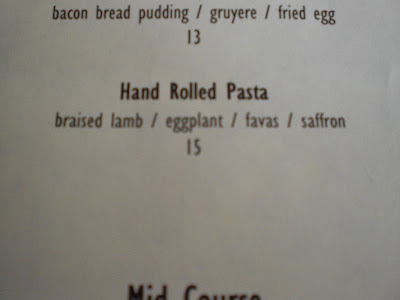 Packaging of chocolate marshmallows at Whole Foods, April 2010. Photo by author.
Packaging of chocolate marshmallows at Whole Foods, April 2010. Photo by author. Menu item at The Foundry on Melrose, April 2010. Photo by author.
Menu item at The Foundry on Melrose, April 2010. Photo by author.Lately, in the food industry, one might think there are many new hired hands. Literally. Labels on food products and menu items in restaurants--no matter the price point--are using descriptors such as "hand rolled," "hand cut," "hand crafted." Crafty hands, we should think, are everywhere plying our pizzas, french fries, pastas, and breads, where once, as I recall, they had limited themselves to "tossing" salads. While there is record unemployment for the body's other parts, demand for hands seems high.
This micro-trend of today's hyper-trendy food world is yet another manifestation of a recurring cultural mood. Nostalgia for an imagined "simple life" tends to grip people when the technologically-driven modern and postmodern worlds alienate us and stress us out. The hands cutting our french fries and rolling our pastas are the hands, we imagine, of a pre-modern hero. It is a romanticized craftsman, pictured living among and working to serve a small, reciprocal community; and working in tandem with the rhythms of the local earth.
Every group who has mourned humans' disconnection from nature and from small communities has tended to resuscitate this figure in some way. The organic and Slow Food movements that some worship today are the latest variant of the nineteenth-century Arts and Crafts movement that rejected the exploitative modern factory, whose symbol was the machine, for the supposedly dignified and joyous labor of handicraft. When we work with our hands, William Morris had argued, we become whole again.
While these movements have legitimate substance to offer, their romanticization of handicraft has always been mystifyingly vague. Part of the problem is exacerbated in the latest food-labeling trend--the emphasis on hands. Is handwork always good? What kind of handwork is good? Doesn't it matter whose hands do the work, and whose brain is directing whose hands in the process? Is my typing on this computer a form of handicraft, or must I be doing something pre-modern with my hands? If so, it is not involvement of hands that matters, but rather certain types of work. And what, exactly, counts as a machine? Isn't something as simple as a knife a sort of machine? Do we have a problem with that? Where do we draw the line, and why? Might the focus on hands be misleading and beside the point of working productively, ethically, and happily?
The food labels I'm seeing lately aren't meant to answer any of those questions. The postmodern marketing folks and those who have learned from them want to be mystifying. Consider the language loopholes: Couldn't a "handcrafted" marshmallow go, at some point, through a piece of machinery? And doesn't "hand rolled" pasta really suggest that only the "rolling" of pasta was done by hand, leaving the bulk of pasta making unaccounted for? Can't "rolling" simply refer to arranging pasta on the plate in a rolled shape? Though evocative of a simpler time, this language has all the self-serving obfuscation of "Made in the U.S.A." This now, technically, can mean that the product so labeled was merely assembled here.
The marketing talent and graphic designers who are busy "brain crafting" this imagery know their consumers' reptilian minds all too well. If we don't question the labels, we will reliably do what we tend to do: conjure visions of the rhythmically natural lives of artisans at the mere sight of "handcrafted" on a product's label and the serifs of its "ye olde" typography.
Never mind whose hands work for whom, whose hands are in whose pockets, and what's changing hands in the process.
Copyright 2010 Alison Pearlman. All rights reserved.
